Designing the aquarium of tomorrow: Lessons from four unique projects
By elevating the unique culture and context of each project, architects can build curiosity, connection, and a passion for conservation into their designs.
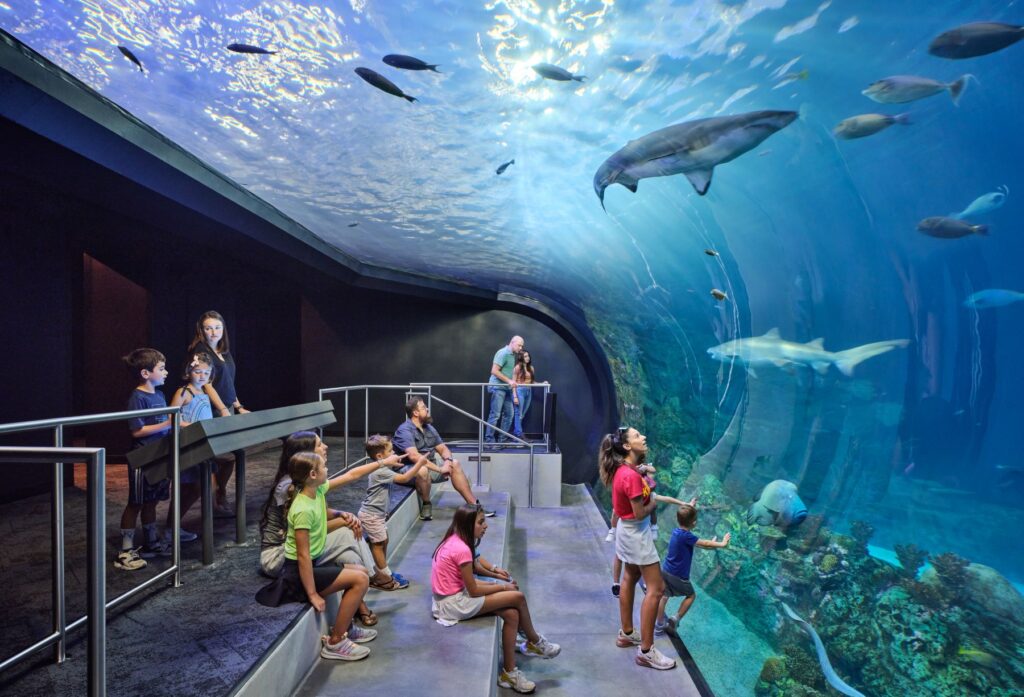
This article was originally published by the Seattle DJC. Read it here.
It came earlier than I anticipated — a phenomenon I suspect is felt by architects around the world who step both feet into a specialized building type. You visit the precedents, and you start to see the patterns. The “best practices” and “must haves” of the past become overbearing trends. Every time you visit that type of project and see the same design ideas repeated, you feel a building sense of urgency to do something different. For me, as I worked on aquarium projects, it was two things. One was the tension between these institutions that champion environmental stewardship, while most of the facilities use more energy than any other building type. The other was the relentlessness of the black box experience.
Today’s institutions feel it, too. They ask, “What is the future of aquarium design?” I would suggest that the answer is twofold: getting serious about climate change and leaning into the unique aspects of institutional culture and context. Comparing four of EHDD’s recent aquarium projects shows how leveraging the unique culture and context of each project allows it to self-differentiate and break away from the tired black box formula.
Toledo Zoo Aquarium Improvement Project
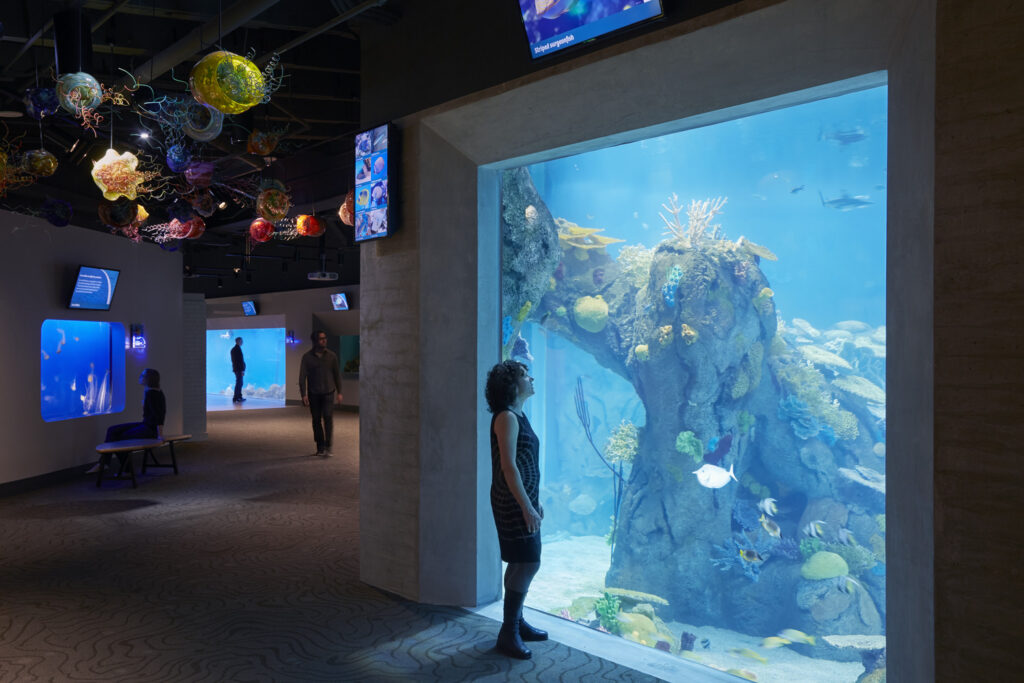
The first aquarium I worked on was a renovation of an existing facility in Toledo, Ohio, embedded in their local zoo. As we wrapped our arms around the project’s ambitions, exploring building sites alongside the Maumee River, we learned that while the exhibit itself was an outdated, repetitive row of small blue boxes, literally falling to pieces after years of unmitigated corrosion, the building itself was a beloved heirloom to the local community. It quickly became clear that this was the key to the project. Revitalizing the existing building offered benefits across a triple bottom line: It would help us shift the slim $20 million budget from construction sitework to creating more dynamic exhibits; it would reduce the project’s embodied carbon; and it would send a clear message of reinvestment in the community and the heart of the Works Progress Administration-era zoo campus.
While the shell had become sacred, the interior was anything but. We looked to create a completely transformed visitor path, restoring the long-abandoned central entry, quadrupling the volume of the exhibits, creating larger tanks that offered multiple viewing experiences, and introducing variety and hands-on experiences. Delivering this level of visitor experience within a defined envelope was like working on a Swiss watch, but our space constraints allowed us to explore a low-energy drum filtration technology, due to the reduced footprint it required.
Pacific Seas Aquarium
At our next aquarium project, we built on the low-energy technology we beta-tested in Toledo. Tacoma’s Point Defiance Zoo wanted to set a new bar for sustainability in aquarium design. This group’s commitment to conservation was unparalleled, and they wanted to walk the walk as we approached the design of their new Pacific Seas Aquarium.
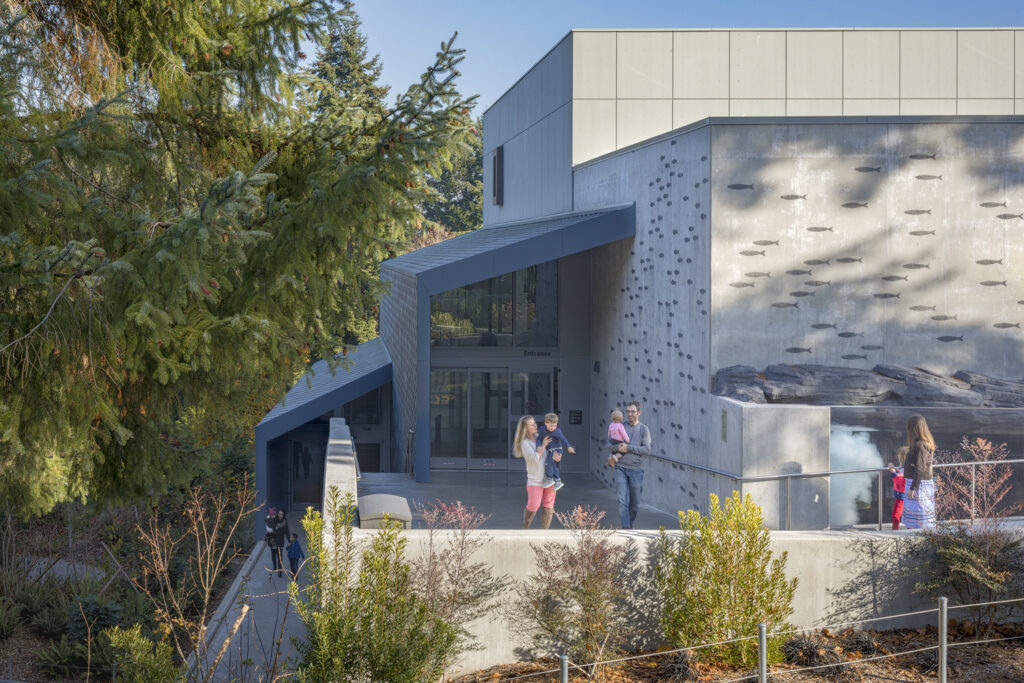
Achieving these significant ambitions meant leaning in to the vertical nature of our steeply sloped site. Our design arranged the water treatment systems to take advantage of gravity, instead of expending energy by pumping multiple times. Beyond this, we used every tool in the book — onsite rainwater capture and re-use, a mass-timber structural system to reduce embodied carbon, and of course, all-electric systems— to deliver the most sustainable aquarium in the country.
The project uses digital personalized engagement at the start and finish of the experience to compel visitors to make individual commitments to actions that help them support ocean health. To emotionally anchor these commitments, and to help visitors register the mostly regional aquatic collection as part of their local environment, we interlaced the visitor path with views to the pine-fringed hillside.
Seattle Aquarium Concept Design
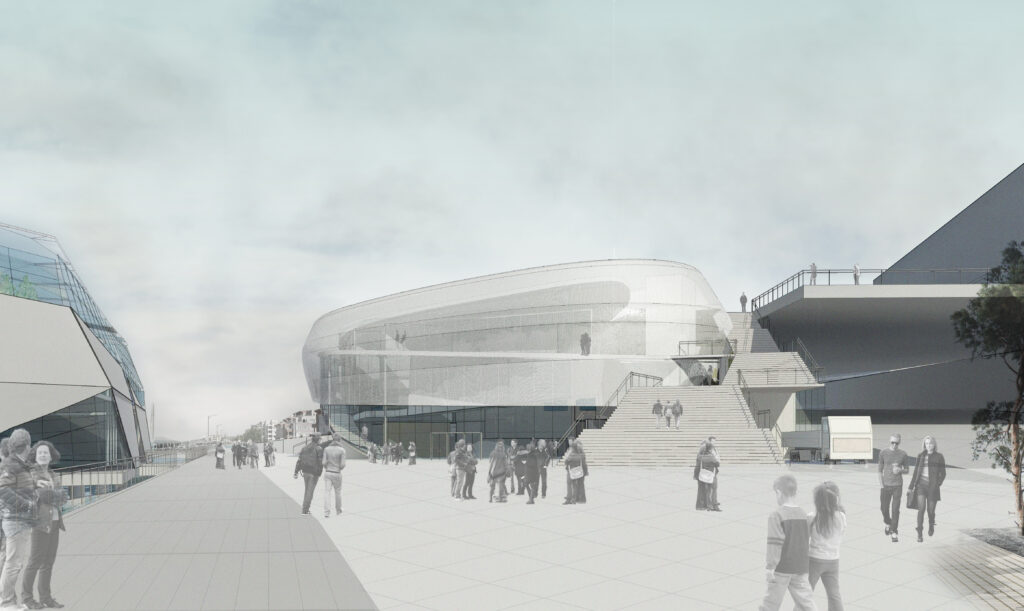
Leveraging the immediate context to flavor the visitor experience played heavily in the campus plan and concept design work we completed for the Seattle Aquarium in 2016. Looking out toward the Olympic range, the Seattle Aquarium has perhaps the most spectacular waterfront view of any existing aquarium. But despite the beauty of its waterfront location, the building is sited in a deeply urban context. Still, we saw this as an opportunity to tell an enhanced story of conservation.
Embracing the urban site, we located the new Ocean Pavilion across the promenade where it would be anchored to the fabric of the waterfront revitalization. This single move yielded opportunities to create visual connections that highlight the urban/natural interface, showing how humans have impacted all aspects of the environment. From a civic perspective, the building becomes a focal point — the jewel sitting at the nexus of the waterfront promenade. It offers many opportunities for generosity to the public — spectacular views from the accessible roof deck, a graceful pedestrian descent from Pike Place Market down to the waterfront, and interpretive opportunities outside the paywall. We’re excited to see that many of these ideas have survived in the design as executed by LMN Architects, and look forward to visiting when it opens this fall.
Sobela Ocean Aquarium
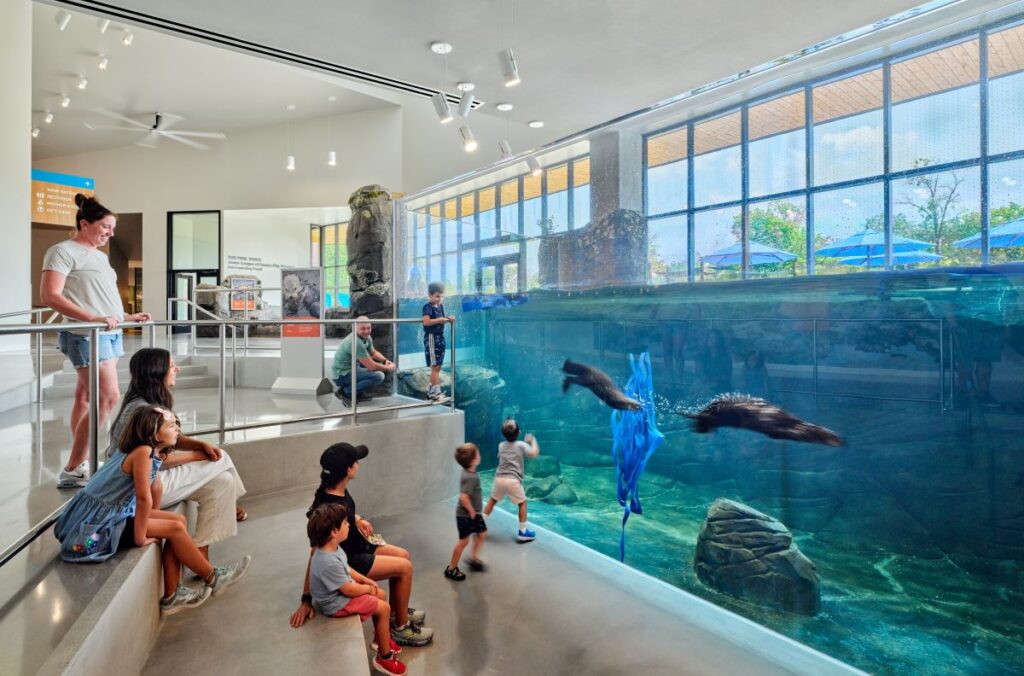
Our most recent aquarium was a very different animal than the Pacific Northwest projects. The Sobela Ocean Aquarium, located on the campus of the Kansas City Zoo, is a 72,000-square-foot, ground-up facility that features 650,000 gallons of water and a broad survey of marine life from sand tigers to nudibranchs. Our charge here was to deliver “wow” — to create an indoor, all-season experience that would draw visitors to the zoo campus all year long.
Deep in the heart of the Midwest, we quickly realized that visitors here come from a different starting point. Many will never visit the ocean, and few will be tuned into the critical role it plays in our climate. This facility was a unique chance to build in them a passion for and connection to the ocean.
To do so, we orchestrated the visitor path to evoke the experience of the ocean, leveraging sensory cues such as light quality, temperature, spatial volume, and sound to foster the emotional bonds built when having the experience in real life. It’s an experience that unfolds to meet you at a human scale, and surprises you with a dynamic, pulsing wave tank, the moment you enter. Overlaid as an interpretive framework: the storyline of ocean currents as the superhighway that interconnects all ecosystems. This storyline ties together a disparate animal collection and is a backbone to showcase the ocean as the key player in the health of our environment.
Every project has its challenges. For the Sobela Ocean Aquarium, it was the COVID-19 pandemic. Our client group had given us the freedom to make the project as sustainable as possible, so long as the measures fit within the budget. As admitted climate warriors, we took this charge, seeking every opportunity to stretch the project performance past our LEED Silver baseline.
Then the wild inflation of 2021 hit. Wood prices were up. Electrical switch gear was up. PVC piping doubled in cost over a month. To keep within arm’s reach of our $61 million construction budget, we had to make some hard decisions. Among these was the return to gas boilers — a hard pill to swallow. In the year since this project opened, I’ve made my peace with it. Our team worked hard to make all-electrical systems cost competitive, and by stretching toward this goal, we delivered a project that really tightened up its energy usage. The truth is, the electrical grid in Kansas City is still fully reliant on fossil fuels; I take solace in the idea that, as it improves, the project we’ve delivered will easily adapt to an all-electric future.
EHDD has been designing aquariums for 40 years. Our journey, starting with Monterey Bay Aquarium, has been characterized by a willingness to challenge the status quo, a tendency to embrace unique cultural and environmental contexts of each project, and a commitment to do right by the environment. As we look toward the “Aquarium of the Future,” it’s clear that elevating the unique aspects of each project is the key to fostering curiosity, connection, and responsibility to the environment that is core to the mission of this industry.